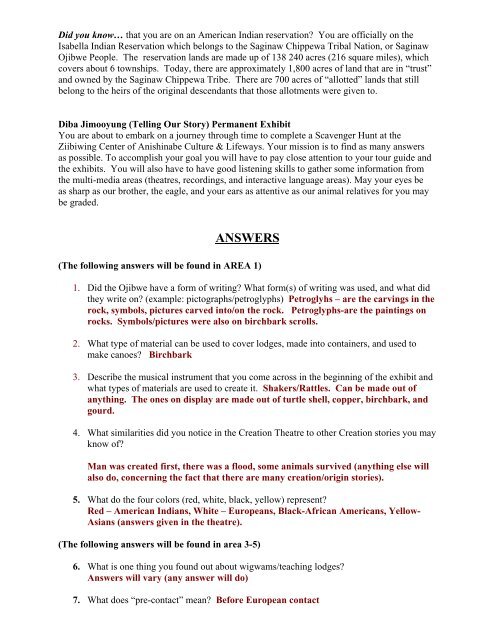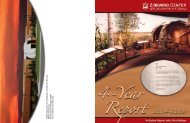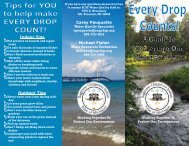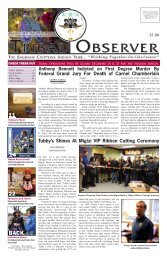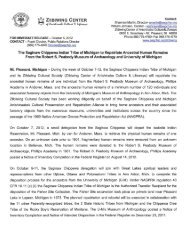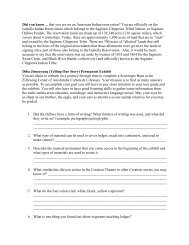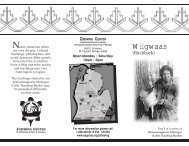ANSWERS - Saginaw Chippewa Indian Tribe of Michigan
ANSWERS - Saginaw Chippewa Indian Tribe of Michigan
ANSWERS - Saginaw Chippewa Indian Tribe of Michigan
Create successful ePaper yourself
Turn your PDF publications into a flip-book with our unique Google optimized e-Paper software.
Did you know… that you are on an American <strong>Indian</strong> reservation? You are <strong>of</strong>ficially on the<br />
Isabella <strong>Indian</strong> Reservation which belongs to the <strong>Saginaw</strong> <strong>Chippewa</strong> Tribal Nation, or <strong>Saginaw</strong><br />
Ojibwe People. The reservation lands are made up <strong>of</strong> 138 240 acres (216 square miles), which<br />
covers about 6 townships. Today, there are approximately 1,800 acres <strong>of</strong> land that are in “trust”<br />
and owned by the <strong>Saginaw</strong> <strong>Chippewa</strong> <strong>Tribe</strong>. There are 700 acres <strong>of</strong> “allotted” lands that still<br />
belong to the heirs <strong>of</strong> the original descendants that those allotments were given to.<br />
Diba Jimooyung (Telling Our Story) Permanent Exhibit<br />
You are about to embark on a journey through time to complete a Scavenger Hunt at the<br />
Ziibiwing Center <strong>of</strong> Anishinabe Culture & Lifeways. Your mission is to find as many answers<br />
as possible. To accomplish your goal you will have to pay close attention to your tour guide and<br />
the exhibits. You will also have to have good listening skills to gather some information from<br />
the multi-media areas (theatres, recordings, and interactive language areas). May your eyes be<br />
as sharp as our brother, the eagle, and your ears as attentive as our animal relatives for you may<br />
be graded.<br />
<strong>ANSWERS</strong><br />
(The following answers will be found in AREA 1)<br />
1. Did the Ojibwe have a form <strong>of</strong> writing? What form(s) <strong>of</strong> writing was used, and what did<br />
they write on? (example: pictographs/petroglyphs) Petroglyhs – are the carvings in the<br />
rock, symbols, pictures carved into/on the rock. Petroglyphs-are the paintings on<br />
rocks. Symbols/pictures were also on birchbark scrolls.<br />
2. What type <strong>of</strong> material can be used to cover lodges, made into containers, and used to<br />
make canoes? Birchbark<br />
3. Describe the musical instrument that you come across in the beginning <strong>of</strong> the exhibit and<br />
what types <strong>of</strong> materials are used to create it. Shakers/Rattles. Can be made out <strong>of</strong><br />
anything. The ones on display are made out <strong>of</strong> turtle shell, copper, birchbark, and<br />
gourd.<br />
4. What similarities did you notice in the Creation Theatre to other Creation stories you may<br />
know <strong>of</strong>?<br />
Man was created first, there was a flood, some animals survived (anything else will<br />
also do, concerning the fact that there are many creation/origin stories).<br />
5. What do the four colors (red, white, black, yellow) represent?<br />
Red – American <strong>Indian</strong>s, White – Europeans, Black-African Americans, Yellow-<br />
Asians (answers given in the theatre).<br />
(The following answers will be found in area 3-5)<br />
6. What is one thing you found out about wigwams/teaching lodges?<br />
Answers will vary (any answer will do)<br />
7. What does “pre-contact” mean? Before European contact
8. What is “pre-contact” clothing <strong>of</strong> Ojibwe (<strong>Chippewa</strong>) peoples made out <strong>of</strong>?<br />
Animal hides/skins (mostly deer, moose, and elk)<br />
9. What types <strong>of</strong> food did Ojibwe (<strong>Chippewa</strong>) peoples eat & depend on before European<br />
contact?<br />
Wild rice, corn, beans, squash, fish, and wild game (deer, moose, etc.)<br />
10. How did Ojibwe (<strong>Chippewa</strong>) peoples travel before European contact?<br />
By canoe, and by walking<br />
11. What do you see were some <strong>of</strong> the roles <strong>of</strong> women in Ojibwe (<strong>Chippewa</strong>) culture?<br />
Making clothes, cooking, gardening<br />
12. What are the “Three Fires” <strong>of</strong> <strong>Michigan</strong>? Ojibwe (<strong>Chippewa</strong>), Odawa (Ottawa), and<br />
Potawatomi. (They all came together to form and alliance/confederacy.)<br />
13. Where did the basic necessities for life come from? From nature (i.e., plants, animals)<br />
(The following answers will be found in area 6)<br />
14. What did Europeans introduce to American <strong>Indian</strong>s that may have made life easier for<br />
them? Material (for clothing), metal axes, iron pots, guns, needles, etc.<br />
15. What was one way in which Ojibwe (<strong>Chippewa</strong>) people decorated their clothing?<br />
By using the beads given to them by tradesmen to decorate/sew onto material.<br />
(The following answers will be found in area 7)<br />
16. What area were the <strong>Saginaw</strong> Ojibwe (<strong>Chippewa</strong>) peoples originally located in before<br />
being moved to today’s reservation? They were originally located closer to <strong>Saginaw</strong><br />
Bay<br />
17. In the year 1830, the map shows you that <strong>Michigan</strong> had over 100 American <strong>Indian</strong><br />
villages. True<br />
18. What do you notice about the clothing on the two mannequins (male & female) in the<br />
showcase? That the clothing is made out <strong>of</strong> red material which was traded (taking<br />
on a European style <strong>of</strong> dress/ European influence)<br />
19. What is a “treaty”? It is a legal document made by the government, which promises<br />
many things.<br />
20. Name three items that were used in exchange for land? Alcohol, money, beads, corn,<br />
blankets, guns, etc.<br />
21. What were some positive effects for American <strong>Indian</strong> peoples in attending “<strong>Indian</strong><br />
Boarding/Governmental/Residential” schools? They were taught how to read & write<br />
in English, mathematics, sewing skills, and farming skills.
22. What were some negative effects for American <strong>Indian</strong> peoples attending “<strong>Indian</strong><br />
Boarding/Governmental/Residential” schools? Were not able to speak their own<br />
language or practice religious beliefs/customs/traditions.<br />
23. What artifact in the “Missionary/Christianity” showcase is from 1844? A bible in the<br />
Ojibwe language<br />
24. American <strong>Indian</strong> peoples were forced to learn and accept Christianity as their own<br />
beliefs. True<br />
(The following answers will be found in area 9)<br />
25. What does the drum beat represent during a song? The heartbeat (it represents the<br />
heartbeat <strong>of</strong> mother earth, and the ancestors)<br />
26. Where did American <strong>Indian</strong> peoples get glass beads from? From the French (fur<br />
traders)<br />
27. What was used before the introduction <strong>of</strong> glass beads? Dyed porcupine quills, seeds,<br />
shells, bone<br />
(The following answers will be found in area 10)<br />
28. What do you notice about Anishinabemowin (Ojibwe language)? Answers will vary<br />
(any answer will do).<br />
(The following answers will be found in area 11)<br />
29. What material was used to make baskets? Wood (Black Ash tree to be exact)<br />
30. Why did American <strong>Indian</strong> peoples make baskets? For survival, to earn a living/make<br />
money (prior to European contact baskets were everyday items used to hold things)<br />
31. Why are the youth important? They are the future leaders (future adults)<br />
32. How is a reservation similar to a town or city? Reservation has many<br />
departments/organizations to help take care <strong>of</strong> community members: police dept.,<br />
fire dept., clinic, court house, seniors program, gym, library, etc.<br />
33. What do you like best about the Veteran’s display? Answers will vary/any answer will<br />
do<br />
(The following answers will be found in area 12)<br />
34. What tribal group did Benjamin Franklin study? Iroquois Confederacy<br />
35.What year did it become okay for American <strong>Indian</strong> peoples to practice their<br />
religion/spirituality? 1978 (29 years ago)
36. What year did Native peoples become <strong>of</strong>ficial U.S. citizens? 1924<br />
(The following answers will be found in area 13)<br />
37. What did you learn from watching the “Eyawiiyang” (Who We Are) video/theatre<br />
presentation? Answers will vary / any answer will do.<br />
(The following answers will be found in area 14)<br />
38. Why is the tribal flag sitting next to the U.S flag? Represents the relationship the<br />
tribe has with the federal government. <strong>Tribe</strong>s are considered a “nation within a<br />
nation”.<br />
39. What is one <strong>of</strong> the treaty rights <strong>of</strong> American <strong>Indian</strong>s? Hunting & fishing, education<br />
40. What is considered a business/corporation that belongs to the <strong>Saginaw</strong> <strong>Chippewa</strong> Tribal<br />
Nation and its members? The Soaring Eagle Casino & Resort<br />
(The following answers will be found in area 15)<br />
41. What are the Seven Grandfather Teachings? Love, respect, bravery, honesty, wisdom,<br />
truth, humility<br />
Congratulations! You have completed the Ziibiwing Center’s Scavenger Hunt dedicated<br />
to helping you achieve your “American <strong>Indian</strong> Culture” Merit Badge.


